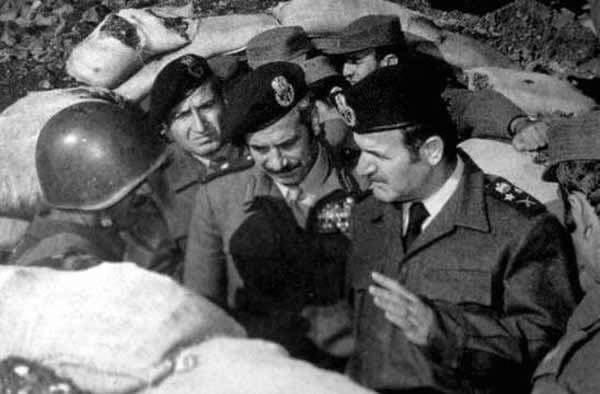
Henry Kissinger and and Hafez al-Assad meet in Damascus in December 1973 (credit: Agence France-Presse stringer, released by Getty in January 1974).
Ken Stein, December 15, 2021
Sandwiched in between the end of the 1973 October Middle East War and convening the December 1973 Geneva Middle East Peace Conference, U.S. Secretary of State Henry Kissinger failed to convince Syrian President Hafez Assad to attend the conference. They met in Damascus on December 15, 1973. Assad refused Kissinger’s entreaties. Kissinger wrongly believed that Syria would attend the upcoming Geneva Middle East Peace Conference. He did not realize how emphatically opposed the Syrian leader was to Egyptian President Anwar Sadat’s collusive collaboration with the U.S. and Israel for only Israeli territorial disengagement from Egypt’s lands. If nothing equivalent was planned for Syria to obtain an Israeli withdrawal from the Golan Heights, Syria was not going to be prop in the U.S. Egyptian theater. Within a month after the war started, Kissinger had become enthralled with Sadat’s mix of using war to enter diplomacy. After the three hour meeting, Assad said ‘no’ to receiving an invitation to the Geneva conference. Sadat was not disappointed. Holding a conference without Syrian presence, meant Damascus could not stand in the way of implementing an Egyptian-Israeli bilateral agreement. Sadat would repeat the same exercise in October 1977 when he said no to Jimmy Carter’s craven desire to convene an international Middle East peace conference: same reason for Sadat four years later, no Assad meant no Syrian veto to an expected bilateral Egyptian-Israeli understanding over Sinai.
In preparing for Kissinger’s Damascus visit, the first of a US Secretary of State since John Foster Dulles was there in the early 1950, David Korn, the U.S. State Department Office Director for Northern Arab Affairs was dispatched to the Syrian capital to arrange the logistics and prepare for the meetings with Assad. Prior to going to Syria, Kissinger met with Sadat on several occasions and momentum for the conference’s negotiating train was picking up speed. Kissinger believed he could easily pick Assad up at the station and the Syrian president would gladly jump aboard. The Jordanians and Israelis were ready to join. But Kissinger did not realize that Assad was in a foul mood about Sadat’s actions the previous two months. They had planned the war together and gone to war against Israel together, but Sadat only wanted a limited military success over Israel and restoring Egyptian honor by capturing lands in Sinai. Assad had wanted an all our Arab victory over Israel and Sadat intentionally crossed-up his partner in war. Sadat knew before the war he would reach out to Kissinger to ignite a diplomatic process. Now came the train’s engineer. Before Kissinger met with Assad, he believed that Assad would attend the proposed international conference. For Kissinger, the questions to be answered were primarily procedural: the timing of the conference, the content and manner in which the letters of invitation to the conference would be sent, and how would Assad provide “Arab cover” for the pre-negotiated Egyptian-Israeli disengagement agreement. As for Kissinger, recalled Korn, the Secretary of State was not bound by a cautious self-estimate of his competency as a negotiator. He calmly remarked to Korn that his “experience in the Vietnam negotiations qualified him to undertake these [Middle East] negotiations. It is my destiny.” Korn thought that Kissinger’s ‘my destiny’ comment was so ridiculously pompous that he almost burst out laughing. After a lunch hosted by Syrian Foreign Minister Khaddam, Kissinger reflected, “It is my destiny which has brought me to this place.” Kissinger did not lack immodesty. He relished this chance. Korn was not as sanguine about Assad either taking a ticket from Kissinger or about his willingness to have it punched. Kissinger was about to receive a heavy dose of Assad’s political reality. At the December 15, 1973 meeting, Kissinger quickly learned that Assad was not Sadat; Assad would be his own political engineer. As this transcript reveals, Assad was an emphatic listener, a strategic thinker, a leader who would not be swept up into winds of change, if political decisions did not first and foremost serve Syria’s geographic national interest, and broader pan-Arab interest of leading Arab politics. Assad put “Sadat’s” Kissinger in his place, knowing full well that sometime later in negotiations after the October 1973 War, Kissinger would have to come back to Damascus as he did in spring 1974, and Assad would be the only focus of Washington’s attention; Assad then quibbled with Kissinger over every kilometer and hill-top as part of an Israeli withdrawal that ended up in the May 1974, Syrian-Israeli Disengagement Agreement. As he would during his thirty years as Syria’s “Machiavellian” president, Assad marched to his own drummer, always focused on advancing Syrian national interests. Assad obtained his first measure of Kissinger and perhaps Kissinger learned an important lesson: that one Arab leader could not speak for another. In 1977-78, Carter too depended too heavily on Sadat and found out that he could not speak for other Arab leaders and their interests.
Ken Stein, December 2021
1. Ken Stein interview with David Korn, October 29, 1993, Washington, D.C.
